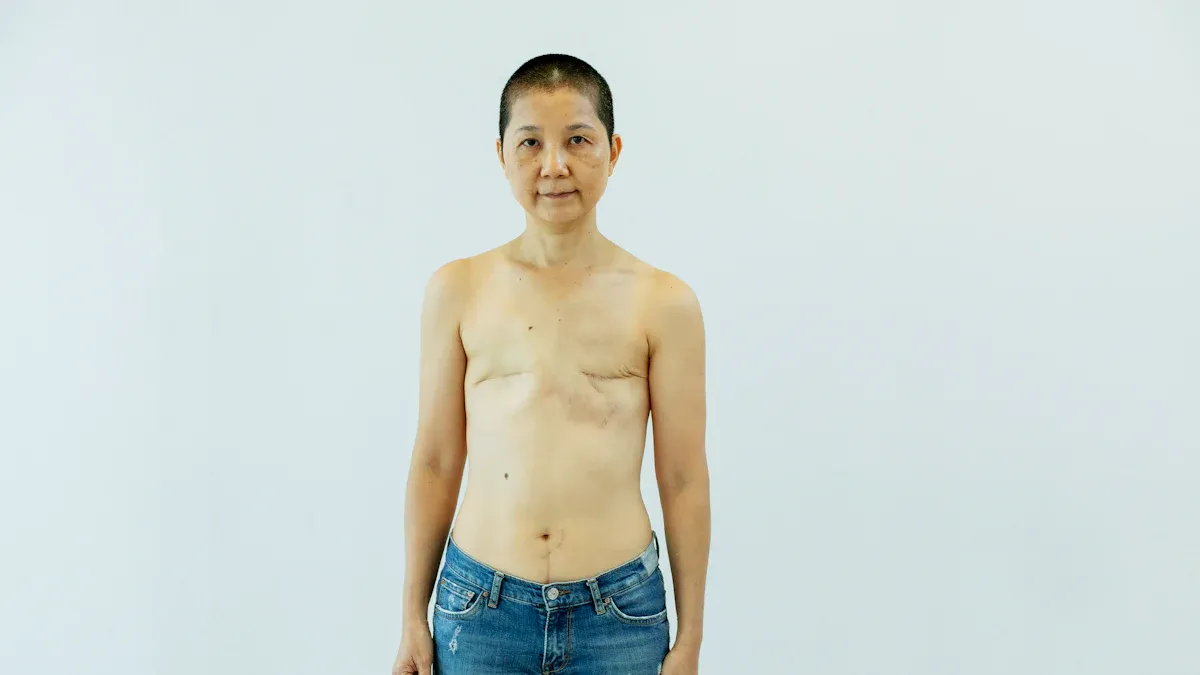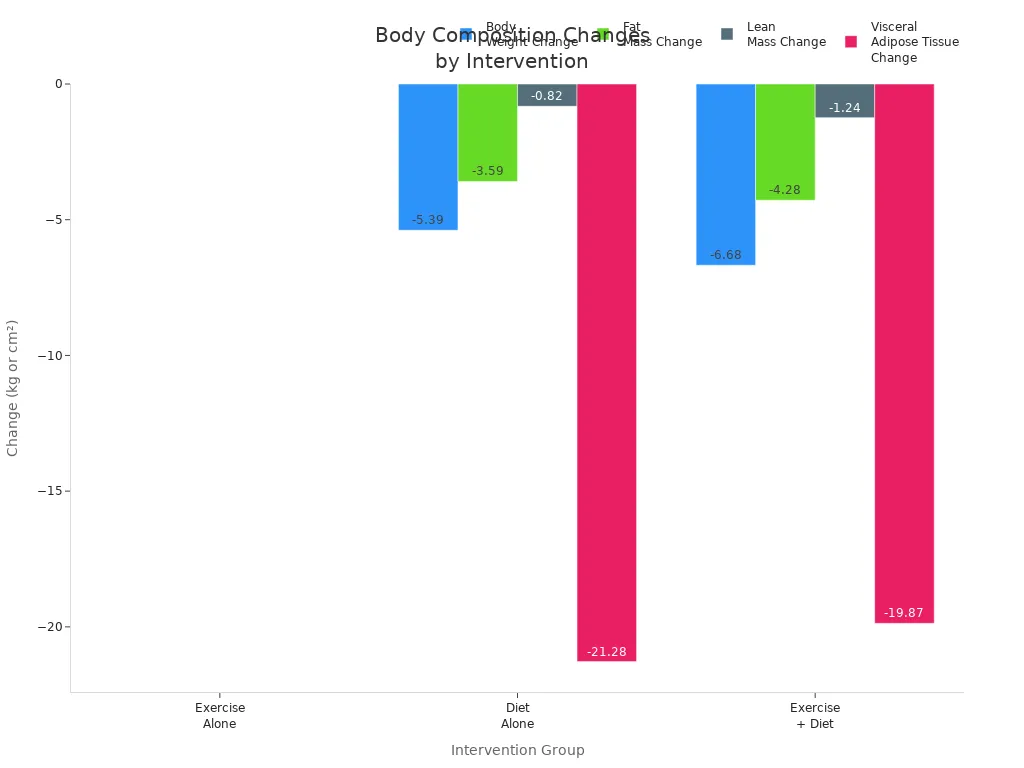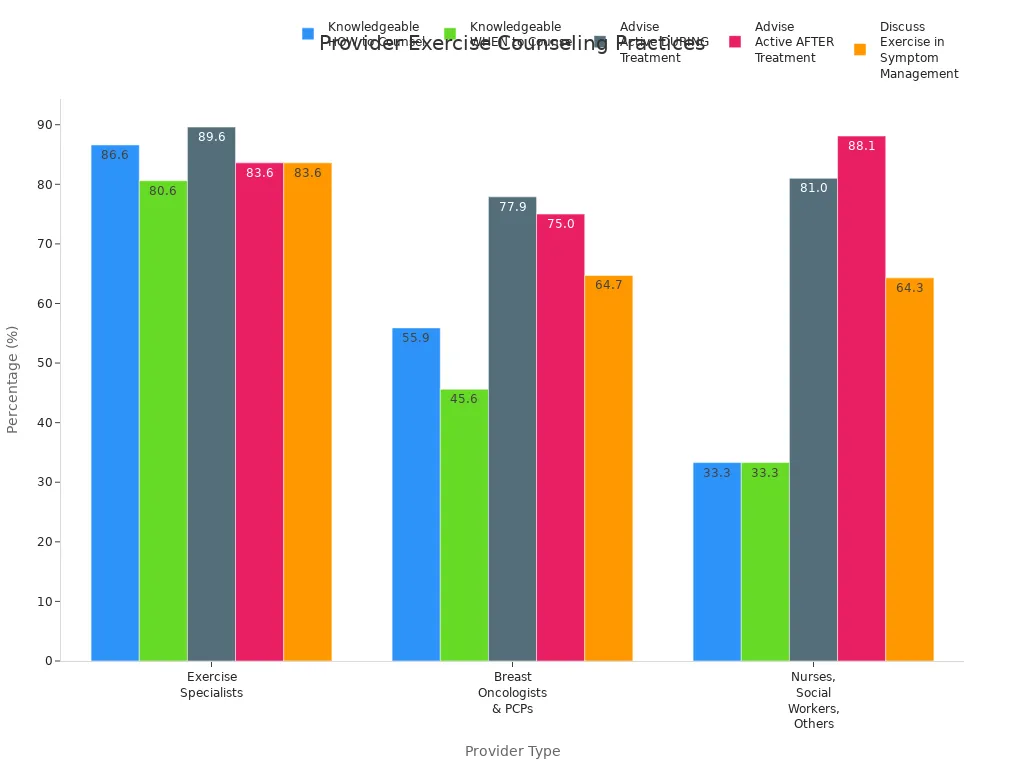HIIT & Resistance Training Boost Anti-Cancer Myokines

Can resistance and high intensity interval training boost anti-cancer myokines in breast cancer survivors? Research shows that even a single session of these exercises leads to a rapid increase in key myokines, such as decorin, IL-6, and SPARC.
Serum levels of these myokines rise by 9 to 47% immediately after exercise.
Both exercise types reduce breast cancer cell growth by up to 29%.
Exercise Type | Survival Outcome | Hazard Ratio | 95% CI |
|---|---|---|---|
Resistance Training | Breast cancer-specific survival | 0.04–0.90 |
These changes offer hope to those seeking better exercise and cancer recovery options.
Key Takeaways
Resistance training and high intensity interval training (HIIT) quickly raise anti-cancer myokines in breast cancer survivors, helping fight cancer cells.
These exercises reduce breast cancer cell growth by up to 30% and improve muscle strength, heart health, and body composition.
Regular exercise lowers harmful inflammation, creating a body environment less friendly to cancer and supporting the immune system.
Supervised exercise programs are safe, effective, and improve quality of life, reducing fatigue and risk of cancer returning.
Starting with guided sessions and gradually increasing intensity helps survivors build strength and fitness safely for long-term health benefits.
Anti-Cancer Myokines
Myokine Release
Resistance training and high intensity interval training help breast cancer survivors by increasing the release of special proteins called myokines. These myokines travel through the blood and can fight cancer cells. Scientists have found that after just one session of exercise, the levels of key myokines rise quickly.
Decorin, IL-6, SPARC, and OSM are the main anti-cancer myokines released.
Their levels can increase by 9–47% right after exercise.
HIIT causes a greater immediate increase in IL-6 compared to resistance training.
Both types of exercise lead to higher myokine levels in the blood.
Myokine | Change Immediately Post-Exercise (RT & HIIT) | Change 30 min Post-Exercise | HIIT vs RT Difference |
|---|---|---|---|
Decorin | Significant increase (9-47%) | Not specified | No significant difference |
IL-6 | Significant increase (9-47%) | Remains elevated | Greater increase in HIIT group |
SPARC | Significant increase (9-47%) | Not specified | No significant difference |
Oncostatin M | Not significantly changed immediately post | Elevated only in RT group | No significant difference |
Note: Scientists measured these changes in breast cancer survivors before and after exercise. The results show that both resistance training and HIIT can boost myokine levels quickly.
Longer exercise programs also help. For example, after 12 weeks of aerobic exercise, breast cancer survivors showed higher levels of Leukemia Inhibitory Factor (LIF) and Interleukin-15 (IL-15). These changes suggest that regular exercise keeps myokine levels higher over time.
Cancer Cell Impact
Myokines released during exercise do more than just travel in the blood. They attack cancer cells directly and help the immune system fight tumors. Laboratory tests show that after exercise, blood from breast cancer survivors can slow down the growth of cancer cells.
Myokines reduce breast cancer cell growth by 20–30% in lab tests.
HIIT leads to stronger suppression of cancer cells than resistance training.
Myokines change the tumor environment, making it harder for cancer cells to survive.
They help immune cells find and destroy cancer cells.
Myokines block signals that cancer cells use to grow and spread.
Researchers found that these proteins can stop cancer cells from multiplying. They do this by blocking important pathways inside the cells, such as the mTOR pathway. Myokines also help immune cells work better, which adds another layer of protection.
🧬 Tip: Even one session of exercise can make blood from breast cancer survivors more powerful against cancer cells. Regular exercise keeps these benefits going and may lower the risk of cancer coming back.
Studies show that survivors who exercise regularly have a lower chance of relapse and death from cancer. Exercise-induced myokines help create a body environment that is less friendly to cancer. This makes exercise a strong tool for breast cancer survivors who want to protect their health.
Body Composition

Fat and Muscle
Consistent exercise changes the body in important ways for breast cancer survivors. Both resistance training and high intensity interval training (HIIT) help reduce fat mass and increase lean muscle mass. These changes do not just improve appearance. They also support better health and lower cancer risk.
Resistance Training (RT) Effect | High-Intensity Interval Training (HIIT) Effect | |
|---|---|---|
Duration | 12 weeks | 12 weeks |
Frequency | 3 days per week | 3 days per week |
% Lean Mass | Significant increase | Significant increase |
% Fat Mass | Significant decrease | Significant decrease |
Muscle Strength | More substantial improvements (e.g., chest press strength +4.7 kg) | Improvements observed, less than RT |
Cardiorespiratory Fitness | Improvement, less than HIIT | More effective improvement (mean difference +1.9 ml/min/kg) |
Adverse Events | None major reported | None major reported |
Resistance training builds muscle strength and size. HIIT improves heart and lung fitness while also reducing fat. Clinical studies show that breast cancer survivors often lose muscle during treatment. This loss can lead to weakness, fatigue, and higher risk of death. Survivors with more muscle mass and strength tend to live longer and feel better. Muscle acts as a protective organ. It helps control inflammation and supports the immune system.
🏋️♀️ Tip: Building and keeping muscle through exercise can help survivors recover faster and lower their risk of cancer coming back.
Exercise vs. Weight Loss
Many people think losing weight is the most important goal after cancer. However, the way weight is lost matters. Diet alone can reduce both fat and muscle. Exercise, especially when combined with diet, helps keep muscle while losing fat.

A large study found that diet alone led to the most weight and fat loss, but also caused some muscle loss. Exercise alone did not change weight much, but it helped keep muscle. Losing fat, not muscle, is key for better cancer outcomes. Survivors who keep more muscle have fewer side effects from treatment and recover faster. Bone health stays stable with both exercise and diet.
Maintaining muscle mass through exercise gives unique anti-cancer benefits that weight loss alone cannot provide.
Inflammation
Tumor Progression
Chronic inflammation plays a major role in breast cancer progression. Scientists have found that inflammation helps cancer cells grow, survive, and spread. Many breast cancer survivors show higher levels of inflammatory markers, such as interleukin 6 (IL-6), tumor necrosis factor alpha (TNF-α), and C-reactive protein (CRP). These markers often remain elevated after treatment.
Chronic inflammation drives tumor cell growth and makes it easier for cancer to return.
High levels of inflammatory markers link to a greater risk of cancer coming back or spreading.
Inflammation weakens the immune system, making it harder for the body to fight cancer.
The tumor environment becomes more supportive of cancer growth when inflammation is present.
Recent studies highlight that chronic inflammation not only starts cancer but also helps it advance. Inflammation allows cancer cells to escape the immune system. This makes it important for survivors to find ways to lower inflammation and protect their health.
Note: Lowering inflammation may help reduce the risk of cancer progression and improve survival for breast cancer survivors.
Exercise Benefits
Exercise, especially resistance training and high intensity interval training (HIIT), can help control inflammation in breast cancer survivors. When people exercise, their muscles release special proteins called myokines. These myokines, such as IL-6, IL-2, IL-8, and IL-10, act differently from the usual proinflammatory markers. Instead of causing more inflammation, they help the body fight it.
Exercise stimulates the release of anti-inflammatory myokines from muscle.
HIIT and resistance training can lower CRP levels, especially with long-term programs.
Exercise improves body composition by reducing fat, which also lowers inflammation.
HIIT boosts insulin sensitivity and helps control blood sugar, both linked to less inflammation.
Some studies show mixed results for changes in IL-6 and TNF-α, but CRP often drops with regular exercise.
High-intensity exercise may cause a short-term rise in inflammation, but over time, it leads to more anti-inflammatory effects. Better body composition and improved metabolism from exercise support lower inflammation. This creates a less friendly environment for cancer cells and helps the immune system work better.
🏃♀️ Tip: Regular resistance and HIIT workouts can help breast cancer survivors lower inflammation and support long-term recovery.
Exercise and Cancer Recovery

Standard of Care
Healthcare professionals now recognize exercise and cancer recovery as closely linked for breast cancer survivors. Exercise is not just an optional activity. It is a vital part of supportive care. Over 100 clinical trials and many meta-analyses show that regular physical activity can lower disease-specific and overall mortality by up to 50%. Survivors who stay active experience fewer symptoms such as fatigue, anxiety, and depression. They also report better sleep, bone health, and quality of life.
Exercise reduces cancer-related fatigue more effectively than medicine.
Resistance training is safe for those with lymphedema.
Cardiorespiratory fitness, muscle strength, and immune function improve with consistent exercise.
Hospital stays become shorter, and treatment side effects like nausea and pain decrease.
Exercise helps prevent other health problems such as osteoporosis, diabetes, and heart disease.
Doctors recommend 150 to 300 minutes of moderate aerobic exercise each week, plus resistance training twice weekly. These guidelines come from organizations like the American College of Sports Medicine and the American Heart Association. Despite strong evidence, exercise and cancer recovery are not always included in standard care. Many survivors face barriers such as lack of time or access to facilities. Collaborative efforts among clinicians, researchers, and allied health professionals can help bridge this gap and improve outcomes.
Exercise Modality | Intensity | Frequency & Duration | Setting & Supervision | Outcomes & Notes |
|---|---|---|---|---|
Resistance Training | 60-80% 1RM, 2-3 sets of 8-12 reps | 2x/week for 6-12 weeks | Supervised, lab-based | Improves muscle strength; often combined with aerobic or HIIT |
High-Intensity Interval Training | 85-100% VO2max or 90-95% HRmax; intervals | 2-3x/week for 6-12 weeks | Supervised, lab-based | Improves cardiorespiratory fitness; prevents fitness decline during treatment |
Combined Aerobic + Resistance | Moderate to high intensity | Group sessions 2x/week for 6 weeks | Supervised | Effective for improving fitness and muscle strength |
Supervised exercise programs show the greatest benefits. Home-based HIIT protocols are still under development. Most studies use lab-based, supervised sessions to ensure safety and effectiveness.
🏥 Note: Exercise and cancer recovery should become a routine part of breast cancer care. Survivors who follow these guidelines gain better health and lower risk of recurrence.
Expert Insights
Leading oncology experts agree that exercise and cancer recovery go hand in hand. They recommend a combination of aerobic and resistance training for breast cancer survivors. This approach lowers mortality risk and improves physical and mental health. HIIT stands out as a time-efficient way to boost cardiovascular fitness. All HIIT studies so far use supervised, lab-based settings, but experts see promise in developing home-based programs.
Aspect | Evidence Summary |
|---|---|
Expert Recommendations | Physical activity reduces mortality risk. Combination of aerobic and resistance training is most effective. |
HIIT Characteristics | HIIT improves cardiovascular function quickly. All interventions supervised and lab-based. |
Resistance Training + HIIT | Combined training improves muscle strength and mass. HIIT alone may not increase muscle strength as much. |
Compliance and Safety | High compliance rates (57%-99%). No serious adverse events reported. |
Barriers | Survivors face time and access challenges. Home-based HIIT programs needed. |
Research Gaps | More studies needed on unsupervised and home-based HIIT. |
Intervention Settings | All reviewed studies supervised by exercise trainers or oncology nurses. |
Outcomes | HIIT prevents decline in fitness. Combined training improves muscle strength. |
Safety remains a top priority. Most adverse events are minor and do not stop survivors from continuing exercise. Serious events are rare. Supervised sessions help prevent injuries and adapt exercises to individual needs. No increased risk of lymphedema has been found in exercise groups.
About 20% of participants report minor injuries or discomfort, mostly in high-intensity groups.
Serious events such as fainting or fractures are very rare.
Exercise during chemotherapy does not increase risk of adverse events.
Supervised exercise programs are recommended for best safety.
Practical strategies help survivors integrate resistance and HIIT into their care plans. Individualized prescriptions based on guidelines ensure safety and effectiveness. HIIT involves short bursts of high-intensity exercise with rest periods, performed 2-3 times per week. Resistance training uses weights, bands, or body weight at moderate intensity, 2-3 days per week. Programs use perceived exertion scales and gradual progression to match each survivor's ability.

Healthcare providers play a key role in exercise and cancer recovery. Exercise specialists show the highest rates of counseling and knowledge. Oncologists and primary care doctors also advise survivors to stay active, but many lack formal training in exercise counseling. National guidelines recommend individualized exercise plans, but practical implementation remains limited.
Survivors benefit most from programs that combine aerobic and resistance training, tailored to their needs. Supervised sessions, gradual progression, and close monitoring help maintain safety and high adherence. These approaches improve strength, fitness, and quality of life.
💡 Tip: Survivors should ask their healthcare team about exercise and cancer recovery options. Individualized plans and supervised sessions offer the best results.
Resistance and high intensity interval training help breast cancer survivors by increasing anti-cancer myokines, improving muscle strength, and lowering inflammation. These exercises offer benefits that go beyond weight loss, such as better heart health, stronger bones, and improved quality of life. Many survivors face barriers to regular activity, but ongoing support and accountability can help. Exercise and cancer recovery work best together, giving survivors a powerful tool to protect their health. Families and healthcare providers should encourage safe, regular movement for every survivor.
FAQ
Can breast cancer survivors safely do resistance training and HIIT?
Doctors say resistance training and HIIT are safe for most breast cancer survivors. Supervised programs help prevent injuries. Survivors should talk to their healthcare team before starting new exercises.
Tip: Start with low intensity and increase slowly for best results.
How quickly do myokines increase after exercise?
Myokine levels rise within minutes after a single session of resistance training or HIIT. Scientists measured increases of 9–47% in key anti-cancer myokines right after exercise.
Myokine | Increase (%) |
|---|---|
Decorin | 9–47 |
IL-6 | 9–47 |
Does exercise help lower the risk of cancer coming back?
Regular exercise lowers the risk of cancer recurrence. Survivors who stay active have fewer relapses and live longer. Exercise also improves strength, mood, and quality of life.
What is the best way to start an exercise program after breast cancer?
Survivors should begin with supervised sessions. They can use light weights or short intervals. Gradual progression helps build strength and fitness safely.
Ask a doctor for advice
Join a supervised group
Track progress weekly
Can exercise replace medication for cancer recovery?
Exercise supports recovery but does not replace medication. Doctors recommend combining exercise with standard treatments for the best outcomes.
Note: Exercise works best as part of a complete care plan.
See Also
A Comprehensive Guide To Bone Malignant Fibrous Histiocytoma
Recognizing The Common Symptoms Of Male Breast Cancer
Key Symptoms And Treatment Options For Duodenal Cancer
